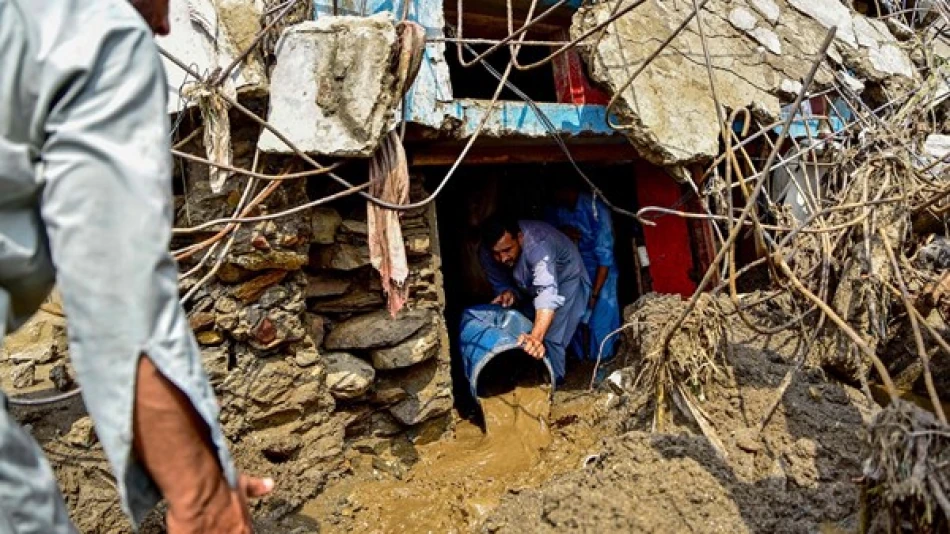
Pakistan Flood Devastation Escalates: Mounting Fatalities Reported
Pakistan's Monsoon Crisis Deepens as Death Toll Soars Past 650 in "Unprecedented" Season
Pakistan faces its deadliest monsoon season in recent memory, with over 344 people killed in just 48 hours as rescue teams struggle to extract bodies from debris across the country's mountainous north. The crisis highlights Pakistan's extreme vulnerability to climate change impacts, with authorities warning that peak monsoon rains have only just begun and will intensify over the next two weeks.
Khyber Pakhtunkhwa Bears the Brunt
The mountainous province of Khyber Pakhtunkhwa, which borders Afghanistan, has emerged as the epicenter of devastation with 307 deaths recorded in the latest 48-hour period alone. The region's rugged terrain and proximity to Afghanistan make it particularly susceptible to flash flooding and landslides during monsoon season.
Most victims died from flash floods, building collapses, electrocution, or lightning strikes. Provincial disaster management authorities have declared multiple areas as "disaster zones" and deployed over 2,000 rescue personnel, though ongoing rainfall continues to hamper relief efforts.
"Heavy rainfall, landslides, and blocked roads are preventing ambulances from reaching affected areas, forcing rescue teams to travel on foot," said Bilal Ahmed Faizi, spokesperson for Khyber Pakhtunkhwa's disaster management agency.
Rescue Operations Face Mounting Challenges
The crisis deepened Friday when a rescue helicopter crashed, killing five additional people and further limiting emergency response capabilities. The incident underscores the dangerous conditions facing both victims and rescue workers in Pakistan's mountainous terrain.
In Buner district, where 91 people have died, rescue efforts are complicated by survivors' reluctance to evacuate. "Rescue teams want to evacuate survivors, but few are willing to leave because their relatives are still trapped under the rubble," Faizi explained.
Communities Devastated, Generations of Work Lost
The human stories emerging from affected areas paint a picture of complete devastation. Mohammad Khan, a 48-year-old resident of Buner district, described waking up to find his family's ancestral farmland completely erased.
"The land our family has farmed for generations, and the small field where we played cricket for years, had vanished," Khan said. "It looks like the mountain collapsed. The area is covered with mud and huge rocks."
Khan personally recovered 19 bodies from the debris, exemplifying how local communities have become first responders in the absence of adequate government resources. The psychological toll is evident as residents describe the mixed emotions of grief and relief when recovering bodies for proper burial.
Tourist Areas and Infrastructure Collapse
The floods have also impacted Pakistan's tourism sector, with five deaths reported in Gilgit-Baltistan, a popular destination for international mountain climbers. Authorities now advise avoiding the region entirely, dealing a blow to Pakistan's already struggling tourism industry.
In Swat district, muddy torrents have submerged roads and vehicles, while electrical infrastructure lies destroyed, leaving communities without power during the crisis.
A Climate Change Reckoning
This year's monsoon season, which authorities describe as "unprecedented," has killed 657 people since June, including hundreds of children, with 888 others injured. Pakistan, the world's fifth-most populous country, ranks among the nations most vulnerable to climate change impacts despite contributing less than 1% of global carbon emissions.
The disaster management data reveals a critical infrastructure problem: over half the casualties resulted from poor building quality, according to Syed Mohammad Tayyab Shah from the National Disaster Management Authority. This points to deeper issues of poverty, inadequate building codes, and insufficient urban planning that amplify natural disaster impacts.
More Devastation Expected
Perhaps most concerning is the timing: authorities warn that peak monsoon season, which typically lasts until mid-September, has only just begun. Weather forecasts predict intensifying rainfall over the next two weeks, suggesting the current death toll may rise significantly.
This pattern reflects broader climate trends affecting South Asia, where monsoon seasons are becoming more erratic and intense. Similar patterns have devastated other regional countries, with Bangladesh and India also experiencing severe flooding in recent years.
Systemic Vulnerabilities Exposed
Pakistan's monsoon crisis exposes the intersection of climate vulnerability, poverty, and inadequate infrastructure that characterizes much of South Asia. Unlike wealthier nations that can invest in flood defenses and early warning systems, Pakistan's limited resources leave communities exposed to increasingly severe weather events.
The reliance on local communities for rescue operations, while demonstrating remarkable resilience, also highlights the absence of adequate state capacity for disaster response. As climate change intensifies weather patterns globally, Pakistan's experience serves as a preview of challenges facing other vulnerable developing nations.
The economic implications extend beyond immediate disaster response, with agricultural losses, infrastructure damage, and tourism impacts likely to compound Pakistan's existing economic challenges. For a country already grappling with political instability and debt burdens, the recurring climate disasters represent an existential challenge that demands both immediate humanitarian response and long-term adaptation strategies.
 Layla Al Mansoori
Layla Al Mansoori







